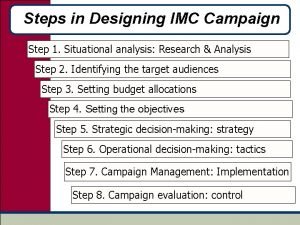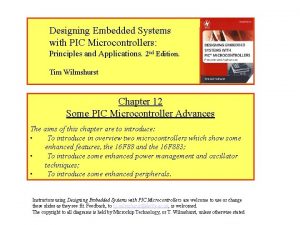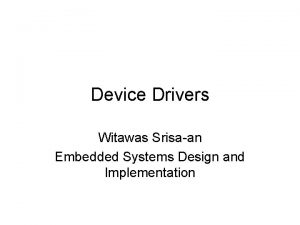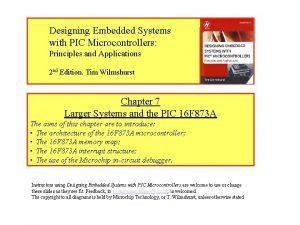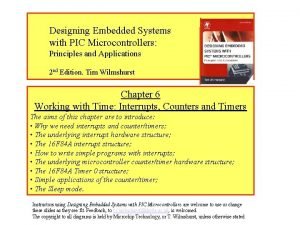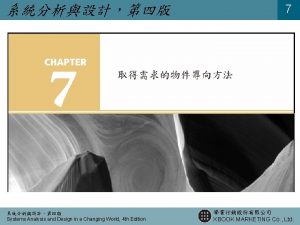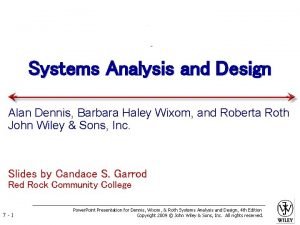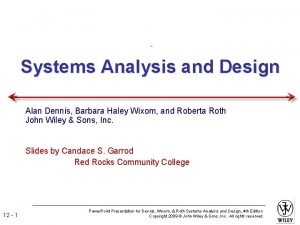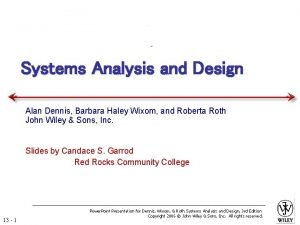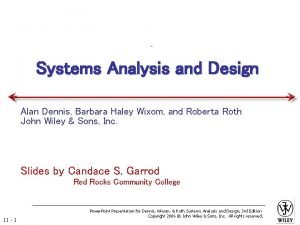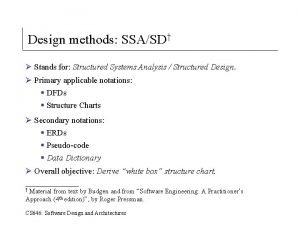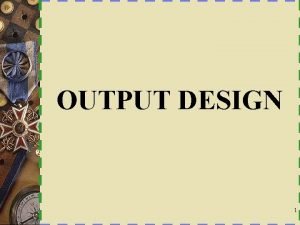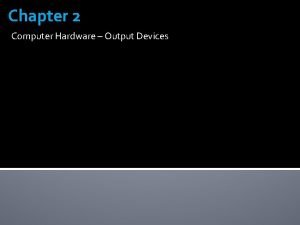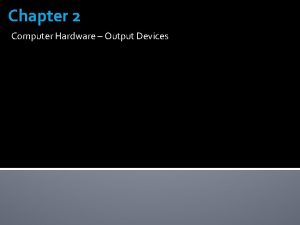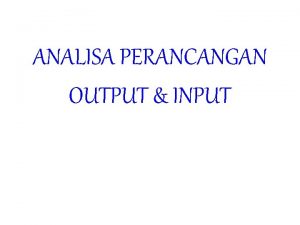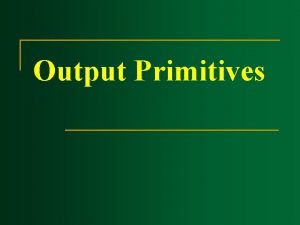Designing Effective Output Systems Analysis and Design 7
















































- Slides: 48

Designing Effective Output Systems Analysis and Design, 7 e Kendall & Kendall © 2008 Pearson Prentice Hall 9

Learning Objectives • Understand the objectives for effective output design • Relate output content to output methods inside and outside the organizational context • Realize how output bias affects users • Design display output • Design tabular and graphic output for users interacting with decision support systems • Design a Web site for ecommerce Kendall & Kendall 11 -2

Output • Information delivered to users • Output forms • Hard-copy - printed reports • Soft-copy - computer screens, microforms, and audio • To create output, the analyst works interactively with the user until the output is satisfactory Kendall & Kendall 11 -3

Major Topics • • • Designing output Output technologies Factors in choosing an output technology Report design Screen design Web site design Kendall & Kendall 11 -4

Output Design Objectives • Serve a specific user or organizational purpose • Meaningful to the user • Deliver the appropriate quantity of output • Make sure the output is where it is needed • Provide output on time • Choosing the right output method Kendall & Kendall 11 -5

Relating Output Content to Method • Content of output must be considered as interrelated to the output method • External – going outside the business • Internal – staying within the business Kendall & Kendall 11 -6

External Output • Examples: • Utility bills • Advertisements • Paychecks • Differs from internal output in: • Distribution • Design • Appearance Kendall & Kendall 11 -7

Internal Output • Examples: • • Summary reports Detailed reports Historical reports Exception reports • Might consist of material available on an intranet Kendall & Kendall 11 -8

Output Technologies • • • Printers Display screen Audio output and Podcasts DVD, CD-ROM and CD-RW Electronic output Kendall & Kendall 11 -9

Printers • The trend in printers is toward increased flexibility • Key factors of printers: • Reliability • Compatibility with software and hardware • Manufacturing support Kendall & Kendall 11 -10

Display Screen • Advantages: • Result in cost savings • May be desirable from the user’s standpoint • Easier to keep up to date • Disadvantages: • Different screen resolutions • Fonts Kendall & Kendall 11 -11

Video, Audio, and Animation • Video • Combines the impact of audio with a visual channel • Audio • Transient, usually output for the benefit of one user • Animation • The presentation of different images in a series, one at a time Kendall & Kendall 11 -12

Video Clips • • • Supplementing static, printed output Distance collaboration Showing how to perform an action Providing brief training episodes Shifting the time of an actual event by recording it for later output • Preserving an important occasion Kendall & Kendall 11 -13

Audio • Sound • Music • Sound effects • Telephone • Podcasting • Technique of putting downloadable voice files on the Web as RSS files Kendall & Kendall 11 -14

Animation • Animation is composed of four elements: • • Kendall & Kendall Elemental symbols Spatial orientation Transition effects Alteration effects 11 -15

CD-ROMs and DVDs • Less vulnerable to damage from human handling • Can include full-color text and graphics as well as audio and video Kendall & Kendall 11 -16

Electronic Output • Electronic mail (email) • Faxes • Bulletin board messages Kendall & Kendall 11 -17

RSS (Really Simple Syndication) • A way of gathering and distributing news and other content from multiple sources • RSS news readers can either stand alone or be integrated with your browser as plug-ins • Has the advantage of efficiently organizing news and other information from a variety of sources chosen by the user Kendall & Kendall 11 -18

Push and Pull Technology • Pull technology allows the user to take formatted data from the Web • Push technology sends solicited or unsolicited information to a customer or client Kendall & Kendall 11 -19

Figure 11. 2 A comparison of output methods Kendall & Kendall 11 -20

Factors to Consider When Choosing Output Technology • • Who will use the output How many people need the output Where is the output needed What is the purpose What is the speed with which output is needed How frequently will the output be accessed How long will the output be stored Regulations depicting output produced, stored, and distributed • Initial and ongoing costs of maintenance and supplies • Human and environmental requirements Kendall & Kendall 11 -21

Output Bias • Analysts must avoid unnecessarily biasing output and make users aware of the possible biases in output • Bias is introduced in three main ways: • How information is sorted • Setting of acceptable limits • Choice of graphics Kendall & Kendall 11 -22

Avoiding Bias in the Design Output • Be aware of the sources of bias • Design of output that includes users • Working with users so that they are informed of the output's biases • Creating output that is flexible and allows users to modify limits and ranges • Train users to rely on multiple output for conducting "reality tests" on system output Kendall & Kendall 11 -23

Designing Printed Output • Detailed Reports • Print a report line for every record on the master file • Exception reports • Print a line for all records that match a certain condition • Summary reports • Print one line for a group of records and are used to make decisions Kendall & Kendall 11 -24

Report Design Conventions • Constant information remains the same whenever the report is printed • Variable information can vary each time the report is printed • Paper quality, type, and size Kendall & Kendall 11 -25

Designing Printed Reports • Functional attributes • Stylistic and aesthetic considerations • Well organized Kendall & Kendall 11 -26

Designing Output for Displays • Keep the display simple • Keep the presentation consistent • Facilitate user movement among displayed output • Create an attractive and pleasing display Kendall & Kendall 11 -27

Graphical Output in Screen Design • • The purpose of the graph The kind of data to be displayed The audience The effects on the audience of different kinds of graphical output Kendall & Kendall 11 -28

Dashboards • • • Make sure the data has content Display the proper amount of summarization and precision Choose appropriate performance measures for display Present data fairly Choose the correct style of graph or chart for display Use well-designed display media Limit the variety of item types Highlight important data Arrange the data in meaningful groups Keep the screen uncluttered Keep the entire dashboard on a single screen Allow flexibility Kendall & Kendall 11 -29

Widgets and Gadgets • Can be any type of a program that may be useful to any person interacting with a computer • Can empower users to take part in design of their own desktop Kendall & Kendall 11 -30

Designing a Web Site • • Use professional tools Studying other sites Use Web resources Examine the sites of professional Web site designers • Use the tools you’ve learned • Consult the books • Examine poorly designed Web pages Kendall & Kendall 11 -31

Designing a Web Site (Continued) • Creating Web templates • Style sheets allow you to format all Web pages in a site consistently • Using plug-ins, audio, and video sparingly Kendall & Kendall 11 -32

Designing a Web Site (Continued) • Plan ahead, pay attention to: • • Kendall & Kendall Structure Content Text Graphics Presentations style Navigation Promotion 11 -33

Structure • One of the most important steps in developing a professional Web site • Each page in the Web structure should have a distinct message • Can benefit from using Web site diagramming and mapping tools Kendall & Kendall 11 -34

Content • Without anything to say, your Web site will fail • Appropriate content is needed to keep the user interested • Use a metaphor or images that provide metaphor for your site • Should include a FAQ page • May take advantage of prewritten software Kendall & Kendall 11 -35

Text • Each Web page should have a title • Place meaningful words in the first sentence appearing on your Web page • Clear writing is important Kendall & Kendall 11 -36

Graphics • Use either JPEG or GIF formats • Keep the background simple and readable • Create a few professional-looking graphics for use on your pages • Keep images small and reuse bullet or navigational buttons • Include text in what is called an ALT attribute for images and image hot spots • Examine your Web site on a variety of displays and screen resolutions Kendall & Kendall 11 -37

Presentation Style • Provide a home page • Keep the number of graphics to a reasonable minimum • Use large and colorful fonts for headings • Use interesting images and buttons for links • Use CSS to control the formatting and layout of the Web page Kendall & Kendall 11 -38

Presentation Style (Continued) • Use divisions and cascading styles or tables to enhance a layout • Use the same graphics image on several Web pages • Use Javascript to enhance Web page layout • Avoid overusing animation, sound, and other elements Kendall & Kendall 11 -39

Navigation • The three-clicks rule • Promote the Web site • Encourage your viewers to bookmark your site Kendall & Kendall 11 -40

Promotion • • Promote your site Submit often to search engines Include key words in metatags Encourage your readers to bookmark your Web site Kendall & Kendall 11 -41

Creating Blogs (Web Logs) • • • Permalink specific for the blog post The headline or title of the post The primary link An optional summary The blog text or commentary An optional image A block quote Links for comments from other people Other blog software features Kendall & Kendall 11 -42

Output Production and XML • An XML document may be transformed into different output media types • Methods: • Extensible Style Language Transformations (XSLT) • Ajax • Cascading style sheets (CSS) Kendall & Kendall 11 -43

Extensible Style Language Transformations (XSLT) XSLT allows you to: • Select XML elements • Sort sequence • Selection of data Kendall & Kendall 11 -44

Figure 11. 21 Extensible style language transformation (XSLT) software can be used to make XML documents and transform them into many different formats for a variety of platforms Kendall & Kendall 11 -45

Ajax • Uses both Java. Script and XML to obtain small amounts of data from a server without leaving the Web page • The user does not have to wait for a new Web page to display after making a selection Kendall & Kendall 11 -46

Cascading Style Sheets (CSS) • CSS allows you to specify the font family, size, color, border and so on • Styles may vary for different media, such as display, print, or handheld devices • Styles do not allow you to manipulate the data Kendall & Kendall 11 -47

Summary • • Output design objectives Output content Output technologies Presentation of output Printed reports Display output Kendall & Kendall 11 -48
 Designing effective input
Designing effective input User interface input and output design
User interface input and output design Designing effective hrd programs pdf
Designing effective hrd programs pdf Designing and developing effective hrd programs
Designing and developing effective hrd programs Ros smith
Ros smith Designing effective input
Designing effective input Purdue powerpoint template
Purdue powerpoint template Imc steps
Imc steps System analysis and design by kendall
System analysis and design by kendall Designing embedded systems with pic microcontrollers
Designing embedded systems with pic microcontrollers Designing machine learning systems
Designing machine learning systems Designing device drivers for embedded systems
Designing device drivers for embedded systems Designing embedded systems with pic microcontrollers
Designing embedded systems with pic microcontrollers Pic architecture diagram
Pic architecture diagram Systems analysis and design in an age of options pdf
Systems analysis and design in an age of options pdf System analysis
System analysis Systems analysis and design in a changing world
Systems analysis and design in a changing world Systems analysis and design in a changing world
Systems analysis and design in a changing world Systems analysis and design dennis
Systems analysis and design dennis System analysis and design
System analysis and design Ssadm tools
Ssadm tools Case tools are limited to systems analysis.
Case tools are limited to systems analysis. Modern systems analysis and design
Modern systems analysis and design Kendall & kendall systems analysis and design
Kendall & kendall systems analysis and design Alan dennis system analysis design
Alan dennis system analysis design Systems analysis and design alan dennis
Systems analysis and design alan dennis Systems analysis and design alan dennis
Systems analysis and design alan dennis Systems analysis and design alan dennis
Systems analysis and design alan dennis Systems analysis and design alan dennis
Systems analysis and design alan dennis Systems analysis and design alan dennis
Systems analysis and design alan dennis Systems analysis and design alan dennis
Systems analysis and design alan dennis Ssadm
Ssadm Radar range equation snr
Radar range equation snr Object-oriented systems analysis and design using uml
Object-oriented systems analysis and design using uml A modern approach to systems analysis and design
A modern approach to systems analysis and design Kendall and kendall system analysis and design
Kendall and kendall system analysis and design Systems analysis and design in a changing world
Systems analysis and design in a changing world Systems analysis and design in a changing world
Systems analysis and design in a changing world Systems analysis and design in a changing world
Systems analysis and design in a changing world Systems analysis and design alan dennis
Systems analysis and design alan dennis Systems analysis and design alan dennis
Systems analysis and design alan dennis Systems analysis and design alan dennis
Systems analysis and design alan dennis Modern systems analysis and design 7th edition
Modern systems analysis and design 7th edition Ssadm model
Ssadm model Essentials of systems analysis and design
Essentials of systems analysis and design Systems analysis and design in a changing world
Systems analysis and design in a changing world Systems analysis and design alan dennis
Systems analysis and design alan dennis Ssasd
Ssasd Systems analysis and design in a changing world
Systems analysis and design in a changing world







